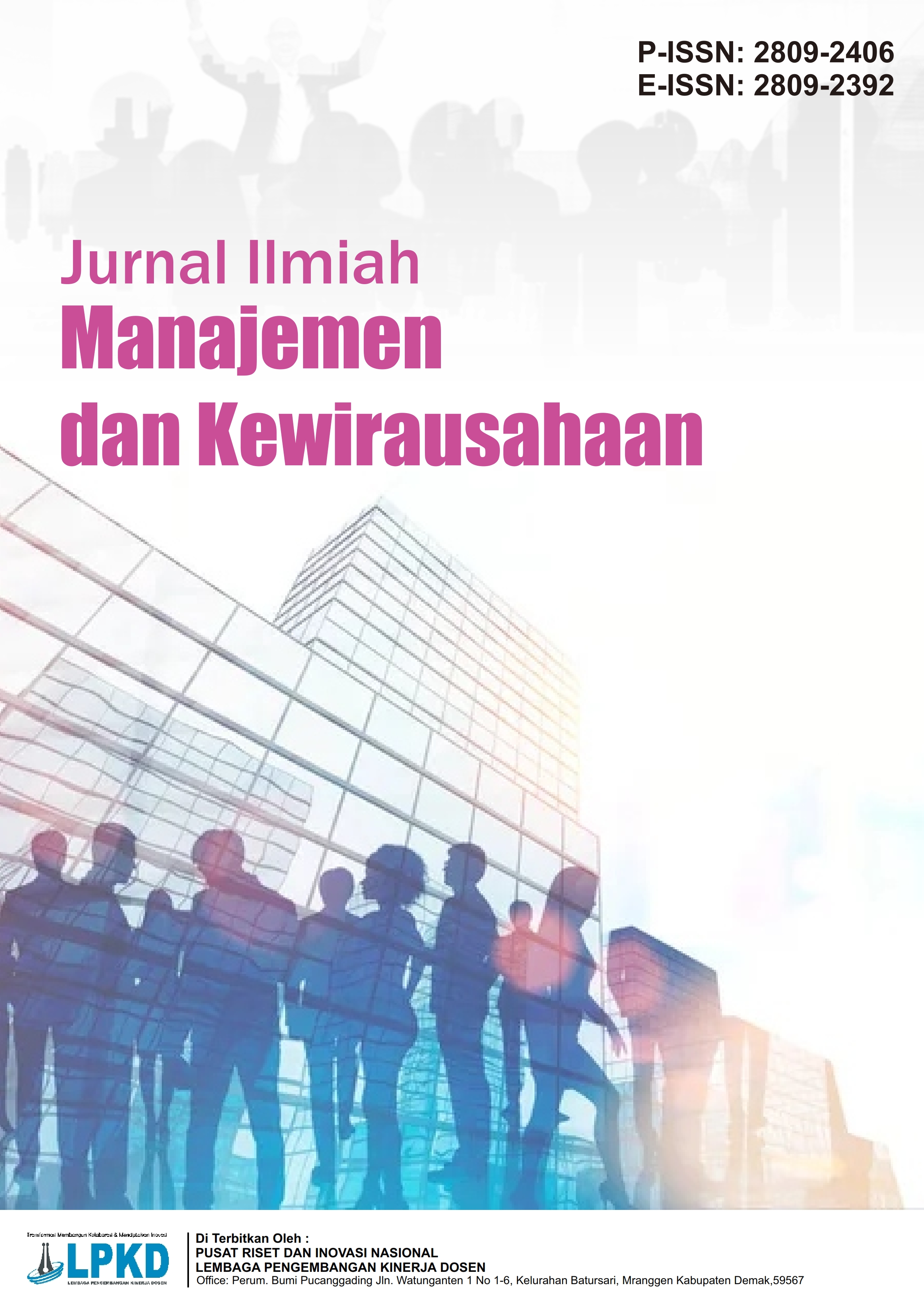Oniomania dan Literasi Keuangan Milenial : Kajian Sistematis atas Perilaku Konsumsi Digital
DOI:
https://doi.org/10.55606/jimak.v4i3.4741Kata Kunci:
Compulsive buying, Digital consumption, Financial literacy, Millennials, OniomaniaAbstrak
Digital transformation is reshaping the way today’s consumers manage their finances, encouraging spending patterns that mirror compulsive buying behaviour oniomania. This study therefore examines how financial literacy influences such compulsive consumption in the context of an increasingly technology‑driven era. Guided by the PICOC framework, this review systematically analyzed six relevant academic articles using a Systematic Literature Review (SLR) approach. Findings indicated that a combination of psychosocial factors such as stress along with a need for social validation, coupled with incentivized digital engagement like tailored ads, online shopping deals, and BNPL payment options contributed to oniomania. Additionally, the components of financial literacy such as knowledge, attitudes towards finance and budgeting skills contributed positively by reducing the likelihood to engage in compulsive consumption. These findings underscored the need for immediate action towards policy change focusing on providing integrated tech-based financial education and developing more responsible digitized financial tools. The review lays down useful concepts for programmatic strategies directed at legislation meant to nurture healthier and sustainability-oriented regimes of digital consumption.
Referensi
Ajzen, I. (1991). The theory of planned behavior. Organizational Behavior and Human Decision Processes, 50(2), 179–211. https://doi.org/10.1016/0749-5978(91)90020-T
Atkinson, A., & Messy, F. A. (2012). Measuring financial literacy: Results of the OECD/INFE pilot study (OECD Working Papers on Finance, Insurance and Private Pensions, No. 15). https://doi.org/10.1787/5k9csfs90fr4-en
Black, D. W. (2007). A review of compulsive buying disorder. World Psychiatry, 6(1), 14–18. https://www.ncbi.nlm.nih.gov/pmc/articles/PMC1805733/ (diakses 7 Maret 2025)
Davis, F. D. (1989). Perceived usefulness, perceived ease of use, and user acceptance of information technology. MIS Quarterly, 13(3), 319–340. https://doi.org/10.2307/249008
Dittmar, H., Long, K., & Bond, R. (2007). When a better self is only a button click away: Associations between materialistic values, emotional and identity–related buying motives, and compulsive buying tendency online. Journal of Social and Clinical Psychology, 26(3), 334–361. https://doi.org/10.1521/jscp.2007.26.3.334
Firli, A., & Hidayati, N. (2021). The influence of financial knowledge, financial attitude, and personality towards financial management behavior on productive age population. Review of Integrative Business and Economics Research, 10(Supplementary Issue 3), 43–54.
Kitchenham, B. (2004). Procedures for performing systematic reviews. Keele University Technical Report TR/SE-0401.
Klarna. (2023). The State of BNPL: Trends and Insights. https://www.klarna.com (diakses 7 Maret 2025)
Lusardi, A., & Mitchell, O. S. (2014). The economic importance of financial literacy: Theory and evidence. Journal of Economic Literature, 52(1), 5–44. https://doi.org/10.1257/jel.52.1.5
Mahdzan, N. S., Sabri, M. F., Husniyah, A. R., Magli, A. S., & Chowdhury, N. T. (2023). Digital financial services usage and subjective financial well-being: Evidence from low-income households in Malaysia. International Journal of Bank Marketing, 41(2), 395–427. https://doi.org/10.1108/IJBM-06-2022-0226
Mehrabian, A., & Russell, J. A. (1974). An approach to environmental psychology. MIT Press.
Owusu, G. M. Y., Bekoe, R. A., Arthur, M., & Koomson, T. A. A. (2023). Antecedents and consequences of compulsive buying behaviour: The moderating effect of financial management. Journal of Business and Socio-Economic Development, 3(3), 197–213. https://doi.org/10.1108/JBSED-04-2021-0049
Page, M. J., McKenzie, J. E., Bossuyt, P. M., Boutron, I., Hoffmann, T. C., Mulrow, C. D., ... & Moher, D. (2021). The PRISMA 2020 statement: An updated guideline for reporting systematic reviews. BMJ, 372, n71. https://doi.org/10.1136/bmj.n71
Paul, J., & Criado, A. R. (2020). The art of writing literature review: What do we know and what do we need to know? International Business Review, 29(4), 101717. https://doi.org/10.1016/j.ibusrev.2020.101717
Ridgway, N. M., Kukar-Kinney, M., & Monroe, K. B. (2008). An expanded conceptualization and a new measure of compulsive buying. Journal of Consumer Research, 35(4), 622–639. https://doi.org/10.1086/591108
Savitha, B., & Hawaldar, I. T. (2022). What motivates individuals to use FinTech budgeting applications? Evidence from India during the COVID-19 pandemic. Cogent Economics & Finance, 10(1), 2127482. https://doi.org/10.1080/23322039.2022.2127482
Schomburgk, L., & Hoffmann, A. (2023). How mindfulness reduces BNPL usage and how that relates to overall well-being. European Journal of Marketing, 57(2), 325–359. https://doi.org/10.1108/EJM-11-2021-0923
Tranfield, D., Denyer, D., & Smart, P. (2003). Towards a methodology for developing evidence‐informed management knowledge by means of systematic review. British Journal of Management, 14(3), 207–222. https://doi.org/10.1111/1467-8551.00375
Tuominen, J., Nyrhinen, J., Rantala, E., & Wilska, T.-A. (2025). Stimulation values and life satisfaction among young people: The role of impulsive buying and financial problems. Young Consumers, 26(7), 92–110. https://doi.org/10.1108/YC-07-2024-2142
We Are Social & Hootsuite. (2024). Digital 2024 Global Overview Report. https://datareportal.com/reports/digital-2024-global-overview-report (diakses 7 Maret 2025)
Unduhan
Diterbitkan
Cara Mengutip
Terbitan
Bagian
Lisensi
Hak Cipta (c) 2025 Jurnal Ilmiah Manajemen dan Kewirausahaan

Artikel ini berlisensiCreative Commons Attribution-NonCommercial-ShareAlike 4.0 International License.







